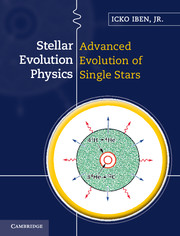Book contents
- Frontmatter
- Contents
- Preface
- Part IV Transport processes, weak interaction processes, and helium-burning reactions
- Part V Evolution during helium-burning phases
- 17 Evolution of a low mass model burning helium and hydrogen
- 18 Evolution of an intermediate mass model burning helium and hydrogen
- 19 Neutron production and neutron capture in a TPAGB model star of intermediate mass
- 20 Evolution of a massive population I model during helium- and carbon-burning stages
- Part VI Terminal evolution of low and intermediate mass stars
- Index
- References
20 - Evolution of a massive population I model during helium- and carbon-burning stages
from Part V - Evolution during helium-burning phases
Published online by Cambridge University Press: 05 December 2012
- Frontmatter
- Contents
- Preface
- Part IV Transport processes, weak interaction processes, and helium-burning reactions
- Part V Evolution during helium-burning phases
- 17 Evolution of a low mass model burning helium and hydrogen
- 18 Evolution of an intermediate mass model burning helium and hydrogen
- 19 Neutron production and neutron capture in a TPAGB model star of intermediate mass
- 20 Evolution of a massive population I model during helium- and carbon-burning stages
- Part VI Terminal evolution of low and intermediate mass stars
- Index
- References
Summary
This chapter describes the evolution of a 25 M⊙ population I model during core and shell helium-burning phases and during core and early shell carbon-burning phases. The initial model, described in Volume 1 (Section 11.3), is burning hydrogen in a shell and has just begun to burn helium in central regions. In Section 20.1 of this chapter, the evolution of central and surface characteristics of the model during the bulk of its quiescent nuclear burning lifetime is compared with the evolution of the same characteristics in 1 M⊙ and 5 M⊙ models during quiescent nuclear burning phases up to the TPAGB phase. The location in the HR diagram of a theoretical pulsational instability strip is compared with the location of a band defined by where core helium burning takes place on a long time scale in models of different mass. The fact that the strip and the band have slopes of opposite sign and intersect makes it possible to understand why there exists a peak in the distribution of Cepheids in an aggregate of stars of the same composition, but of different masses and ages. The peak occurs at the intersection of the strip and the band.
In Section 20.2, the evolution of internal structure and composition characteristics of the 25 M⊙ model during the core helium-burning phase is described in some detail, with particular attention paid to the neutron-capture nucleosynthesis in the convective core occasioned by the activation of the 22Ne(α, n)25Mg neutron source.
- Type
- Chapter
- Information
- Stellar Evolution Physics , pp. 1339 - 1390Publisher: Cambridge University PressPrint publication year: 2012



